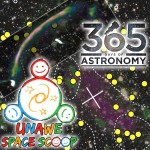Podcaster: Richard Drumm
 Title: Space Scoop: Cosmic Tidal Wave Wakes Up Sleeping Galaxies
Title: Space Scoop: Cosmic Tidal Wave Wakes Up Sleeping Galaxies
Organization: 365 Days Of Astronomy
Link : astrosphere.org ; http://unawe.org/kids/unawe1515/
Description: Space scoop, news for children.
Bio: Richard Drumm is President of the Charlottesville Astronomical Society and President of 3D – Drumm Digital Design, a video production company with clients such as Kodak, Xerox and GlaxoSmithKline Pharmaceuticals. He was an observer with the UVa Parallax Program at McCormick Observatory in 1981 & 1982. He has found that his greatest passion in life is public outreach astronomy and he pursues it at every opportunity.
Today’s sponsor: This episode of “365 Days of Astronomy” is sponsored by — no one. We still need sponsors for many days in 2015, so please consider sponsoring a day or two. Just click on the “Donate” button on the lower left side of this webpage, or contact us at signup@365daysofastronomy.org.
Transcript:
This is 365 Days of Astronomy. Today we bring you a new episode in our Space Scoop series. This show is produced in collaboration with Universe Awareness, a program that strives to inspire every child with our wonderful cosmos.
Today’s story is…
Cosmic Tidal Wave Wakes Up Sleeping Galaxies
The nearest star to our Solar System, Proxima Centauri, is 39.9 trillion kilometers away, or about 4.24 light years away. But despite the vast distances between stars, the Universe is a social place. Planets orbit stars, stars live in galaxies, and galaxies often live in clusters with other galaxies.
One big, happy family!
Galaxy clusters are like cities, where thousands of galaxies are packed together. This includes a mix of bright young galaxies and “sleeping” or “retired” old-timer galaxies that stopped making new stars long ago.
<“You kids get off my lawn!”>
Over billions of years, galaxy clusters merge with neighboring clusters, like growing cities absorbing nearby towns. When this happens there is a huge release of energy as the clusters crash together.
The colorful space photograph in today’s album artwork shows the shock wave created by two merging clusters collectively known as the Sausage Cluster in the constellation Lacerta.
And?
And what?
Y’know…
You’ve GOT to be kidding. I don’t have a sausage sound effect.
There is no such thing! Take off, eh!
Ahem…
The shock wave travels through the clusters like a tidal wave, a tsunami of star stuff. But until now there was no evidence that it affected the galaxies very much.
Astronomers have now found that these retired, oldster galaxies were transformed by these shock waves. It sparked new life into the galaxies by restarting star birth.
It’s kind of like a teaspoon stirring creamer into a cup of coffee. The shock waves lead to turbulence in the galactic gas. These then trigger an avalanche-like collapse, which eventually leads to the formation of very dense, cold gas clouds. These are the necessary ingredients for the birth of new stars.
Think of it like this. The galaxy’s stars are very distant from each other and during a galaxy collision no two stars are likely to collide. However, though the space between stars, the interstellar space, is a vacuum, it isn’t a perfect vacuum. There is a very thin and mostly hydrogen and helium gas there.
The interstellar gas part of the galaxy does collide with the gas part of the other galaxy and this concentrates the thin gas into a denser shock wave. It’s dense enough to begin to gravitationally collapse into new stars.
That’s what you get when 2 galaxies collide. Here with the Sausage Cluster we have 2 galaxy clusters colliding. Just as there is thin gas between stars within a galaxy, there is also thin gas between galaxies! Gas that is not part of any one galaxy.
It is this intra-cluster gas, gas that is between galaxies that is forming shock waves during the cluster collision, shock waves that are sweeping past individual galaxies and triggering star formation in them.
The shocks only lead to a brief increase in the number of new stars forming. The cosmic tidal wave leads to the birth of massive stars that exist just a short time, a few million years, before exploding as violent supernovae! The supernovae create a smaller shock wave that leads in its turn to more star formation.
This shock wave is enriched with metals like iron & nickel and all the good things we need for planet formation due to the way massive stars run through their various fuels. Thanks, supernova! You just made life possible! Next stop pizza, beer & grad students! Woo hoo!
Here’s a Cool Fact
Every cluster of galaxies in the nearby universe has experienced a series of mergers through its lifetime. The Milky Way itself is merging even now with a number of dwarf galaxies and will merge in a few billion years with the Andromeda Galaxy and the Triangulum Galaxy. Stay tuned! The fun is just beginning!
Thank you for listening to 365 Days of Astronomy!
End of podcast:
365 Days of Astronomy
=====================
The 365 Days of Astronomy Podcast is produced by NUCLIO. Audio post-production by Richard Drumm. Bandwidth donated by libsyn.com and wizzard media. You may reproduce and distribute this audio for non-commercial purposes. Please consider supporting the podcast with a few dollars (or Euros!). Visit us on the web at 365DaysOfAstronomy.org or email us at info@365DaysOfAstronomy.org. This year we celebrate cosmic light as light is our info messenger in the universe. Join us and share your story to celebrate the International Year of Light. Until tomorrow! Goodbye!

